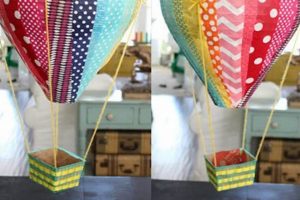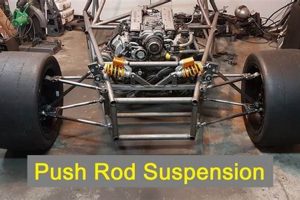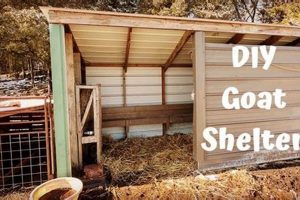Creating recreational structures in residential outdoor spaces through personal construction efforts offers a cost-effective and customizable approach to providing children with engaging play environments. These projects often involve utilizing readily available materials and plans to build swingsets, slides, climbing frames, and other playground features within the confines of one’s property.
The significance of these undertakings lies in their potential to promote physical activity, creativity, and social interaction among children, all within the familiar and secure setting of their own homes. Historically, constructing play equipment at home was common, reflecting a desire for individualized designs and greater parental control over safety and play experiences. Benefits include tailoring the structure to fit specific space constraints and aesthetic preferences, as well as fostering a sense of accomplishment through hands-on creation.
This article will explore the various aspects involved in the construction of these structures, including planning and design considerations, material selection, essential tools and techniques, safety protocols, and ongoing maintenance requirements.
Construction Strategies for Residential Recreational Structures
The following strategies provide guidance for constructing durable and safe recreational structures within residential outdoor spaces.
Tip 1: Comprehensive Planning: Prioritize a detailed design phase involving precise measurements of the available space. Incorporate safety clearances around each play feature. Adherence to a well-defined plan minimizes errors and material waste.
Tip 2: Material Selection: Opt for pressure-treated lumber specifically designed for outdoor use. Ensure all wood is free from splinters and sharp edges. Stainless steel hardware is recommended for superior corrosion resistance and longevity.
Tip 3: Foundation Stability: Implement a robust foundation system for all support posts. Concrete footings extending below the frost line prevent shifting and ensure structural integrity. Proper drainage around the base is crucial to mitigate moisture damage.
Tip 4: Secure Fastening: Utilize appropriate fasteners, such as lag screws and bolts, to securely connect all structural components. Regularly inspect and tighten connections to maintain stability and prevent loosening over time. Over-tightening can strip wood so follow the recommended guidelines.
Tip 5: Safety Surfacing: Install an impact-absorbing surface beneath and around the play structure. Options include engineered wood fiber, rubber mulch, or poured-in-place rubber. Ensure the surface depth complies with safety standards for fall height protection.
Tip 6: Regular Inspections: Establish a routine inspection schedule to identify potential hazards. Examine all components for signs of wear, damage, or corrosion. Address any issues promptly to prevent accidents.
Tip 7: Adherence to Safety Standards: Consult and comply with relevant safety guidelines and building codes. The Consumer Product Safety Commission (CPSC) provides valuable resources and recommendations for constructing safe play environments.
Diligent application of these strategies promotes the creation of safe, durable, and enjoyable recreational structures, ensuring long-term value and minimizing potential risks.
The subsequent sections will delve into specific construction techniques and maintenance procedures for enhancing the lifespan and safety of these residential recreational structures.
1. Planning & Design
Effective planning and design are foundational to the success of constructing recreational structures in residential outdoor spaces. Inadequate preparation can result in structures that are unsafe, structurally unsound, or unsuitable for the available area. A comprehensive plan addresses dimensions, intended user age, feature selection, and anticipated load-bearing requirements. For instance, a playset intended for younger children will necessitate lower platform heights and features specifically designed for smaller hands and bodies. Conversely, a playset for older children might incorporate more challenging climbing elements and higher platforms. Without careful planning, these needs may not be met, leading to a structure that is either unsafe or underutilized.
Detailed designs should incorporate safety clearances around all play features, as dictated by relevant safety standards. The selection of specific features, such as swings, slides, or climbing walls, directly influences the overall footprint and structural requirements. Failure to account for these factors can result in a structure that is too large for the designated area or that lacks adequate support for the intended activities. Moreover, the design phase must consider the existing landscape, accounting for trees, utility lines, and other obstacles that may impact the placement and configuration of the structure. The inclusion of landscaping elements, such as mulch or rubber surfacing, is also a critical aspect of the overall design, contributing to both safety and aesthetic appeal.
In summary, thorough planning and design are essential prerequisites for creating a safe, functional, and aesthetically pleasing recreational structure. A well-conceived plan minimizes the risk of errors during construction, reduces material waste, and ensures that the finished product meets the needs of its intended users while adhering to relevant safety standards. Neglecting the planning and design phase can lead to costly rework, safety hazards, and ultimately, a diminished play experience.
2. Material Selection
Material selection constitutes a critical determinant in the longevity, safety, and overall success of residential recreational structures. The inherent properties of chosen materials directly influence the structural integrity, resistance to environmental factors, and the potential for user injury. Careful consideration must be given to factors such as durability, weather resistance, cost, and ease of workability.
- Wood Durability and Treatment
Pressure-treated lumber, specifically designed for outdoor use, is a common choice. This treatment inhibits rot, decay, and insect infestation. The specific type of treatment, such as chromated copper arsenate (CCA) or alkaline copper quaternary (ACQ), impacts the material’s environmental impact and safety. Untreated wood is generally unsuitable due to its susceptibility to rapid deterioration. Consider the lifespan of the wood type and the sustainability of its harvesting.
- Hardware Corrosion Resistance
The selection of fasteners, such as screws, bolts, and connectors, dictates the structural integrity and long-term stability. Stainless steel or galvanized steel hardware is recommended to prevent corrosio
n, particularly in environments with high humidity or exposure to saltwater. Inferior hardware can lead to premature failure of structural connections, posing significant safety risks. The grade and size of the hardware must be appropriate for the intended load-bearing requirements. - Surfacing Material Impact Absorption
The surfacing material beneath and around the structure directly affects the severity of potential injuries resulting from falls. Engineered wood fiber (EWF), rubber mulch, and poured-in-place rubber are common options. Each material exhibits varying levels of impact absorption, drainage characteristics, and maintenance requirements. The depth of the surfacing material must comply with safety standards for the maximum fall height of the structure.
- Alternative Material Considerations
Beyond traditional wood construction, alternative materials such as recycled plastics and metal frameworks offer distinct advantages. Recycled plastics are resistant to rot and require minimal maintenance but may have higher initial costs. Metal frameworks provide exceptional strength and durability but necessitate specialized tools and expertise for construction. The choice of alternative materials should be based on a comprehensive assessment of their cost-effectiveness, environmental impact, and suitability for the specific application.
The informed selection of materials is paramount to ensuring the safety, durability, and longevity of any constructed recreational structure. Neglecting material considerations can lead to structural failures, increased maintenance costs, and potential hazards to users. A comprehensive understanding of material properties and their suitability for the intended application is essential for responsible and effective execution of these building projects.
3. Structural Integrity
The correlation between structural integrity and the successful construction of residential recreational structures is direct and consequential. Substandard structural integrity in these constructions can lead to catastrophic failures, resulting in serious injuries. The forces exerted by children during play, including dynamic loads from swinging, climbing, and sliding, necessitate a robust and stable framework. Cause-and-effect relationships are evident; for instance, insufficient footing depth or inadequate beam support directly results in instability and a heightened risk of collapse. Consider a scenario where a swing set’s A-frame support legs are not properly anchored. The repetitive swinging motion places increasing stress on the joints, eventually leading to metal fatigue or wood splitting, culminating in the structure’s collapse and potential injury to the user.
The importance of structural integrity manifests in several practical applications. Load calculations, based on the anticipated weight of users and dynamic forces, dictate the required dimensions and material specifications of structural components. Proper joinery techniques, such as using appropriately sized bolts and lag screws, ensure secure connections between wooden members. Bracing and triangulation strategies enhance stability and resist lateral forces. Inspections are crucial; vigilant monitoring for signs of wear, corrosion, or wood decay enables timely repairs and prevents minor issues from escalating into major structural problems. Regular tightening of bolts and screws and the application of wood preservatives are essential maintenance practices.
In summary, structural integrity constitutes a non-negotiable aspect of residential recreational structure construction. Its absence invariably leads to hazardous conditions. Overcoming challenges related to ensuring structural integrity requires meticulous planning, precise execution, and consistent maintenance. A comprehensive understanding of structural principles and adherence to established safety guidelines are paramount in mitigating risks and creating a safe and durable play environment.
4. Safety Compliance
Adherence to established safety standards represents an indispensable element in the domain of constructing residential recreational structures. Neglecting these standards introduces elevated risks of injury and potential liability, undermining the purpose of providing a secure play environment. A structured approach to safety compliance mitigates hazards and ensures the constructed environment aligns with recognized best practices.
- Fall Height Mitigation
Fall height represents a primary safety concern. Safety compliance necessitates adherence to maximum fall height thresholds dictated by standards such as ASTM F1148. This includes implementing appropriate surfacing materials, such as engineered wood fiber or rubber mulch, at specified depths to cushion falls. Failure to comply with fall height regulations can result in severe head trauma and skeletal injuries.
- Entrapment Prevention
Entrapment hazards pose a significant risk, particularly for younger children. Compliance with safety standards mandates meticulous design to eliminate openings within a size range that could trap a child’s head or limbs. This involves carefully considering the dimensions of spaces between railings, ladders, and other structural components. Non-compliance can lead to strangulation or other serious injuries.
- Protrusion and Sharp Edge Elimination
Safety standards require the elimination of protrusions and sharp edges that could cause lacerations or puncture wounds. This involves meticulous inspection and modification of all surfaces to ensure they are smooth and free from hazardous projections. Compliance necessitates the use of rounded edges, recessed hardware, and protective caps on exposed bolts or screws.
- Material Safety and Chemical Exposure
Adherence to safety standards involves the selection of materials that are free from hazardous chemicals. Pressure-treated lumber, for example, must meet specific requirements to minimize the risk of exposure to harmful substances. Compliance requires verification that all materials used are compliant with relevant environmental regulations and do not pose a health risk to users.
The aforementioned facets of safety compliance represent fundamental considerations in constructing residential recreational structures. A rigorous approach to safety minimizes potential risks and ensures that the play environment conforms to recognized safety benchmarks. These insights directly influence the value and secureness of any do-it-yourself venture into constructing backyard playsets.
5. Maintenance Practices
Consistent and diligent upkeep is crucial for ensuring the long-term safety, functionality, and structural integrity of residential recreational structures. These practices directly influence the lifespan of the structure and the well-being of its users. Neglecting maintenance procedures can lead to accelerated deterioration, compromised safety, and ultimately, the need for costly repairs or replacement.
- Hardware Inspection and Tightening
Regular inspection of all bolts, screws, and c
onnecting hardware is essential. Vibrations and weather exposure can cause fasteners to loosen over time, compromising the structural stability of the playset. Tightening loose hardware using appropriate tools prevents potential failures and reduces the risk of accidents. For instance, a swing set’s A-frame support legs could detach if bolts are not periodically checked and tightened, posing a significant safety hazard. - Surface Treatment and Preservation
Wooden components require periodic treatment with weather-resistant sealants or preservatives to protect against moisture damage, rot, and insect infestation. Application of these treatments extends the lifespan of the wood and maintains its structural integrity. Without such treatment, wooden surfaces can become brittle, splintered, and prone to collapse, increasing the risk of injury. Sealants also assist in deterring the growth of mold and mildew.
- Safety Surfacing Maintenance
Surfacing materials such as engineered wood fiber (EWF) or rubber mulch require regular maintenance to ensure adequate impact absorption. EWF needs to be raked and leveled periodically to maintain a consistent depth. Rubber mulch may require replenishing to compensate for displacement due to weather and use. Inadequate maintenance of safety surfacing compromises its ability to cushion falls, increasing the risk of serious injuries.
- Structural Component Assessment
Periodic inspection of all structural components, including support beams, platforms, and ladders, is necessary to identify signs of wear, damage, or corrosion. Cracks, splits, or warping in wooden members can indicate structural weakness. Corrosion on metal components can compromise their load-bearing capacity. Addressing these issues promptly through repairs or replacements prevents more significant problems from developing.
The consistent execution of these maintenance practices is essential for preserving the safety and extending the service life of residential recreational structures. These seemingly minor tasks collectively contribute to a safer and more enjoyable play environment, safeguarding users from potential harm and maximizing the investment in constructing the play equipment. The longevity of a project is intrinsically tied to consistent maintenance, reinforcing its importance in all stages of construction and ownership.
Frequently Asked Questions
The following questions address common inquiries and concerns pertaining to the construction of recreational structures in residential outdoor spaces. The information provided serves to clarify key considerations and dispel potential misconceptions.
Question 1: What are the fundamental safety standards governing the construction of residential recreational structures?
Primary standards include those established by the Consumer Product Safety Commission (CPSC) and the American Society for Testing and Materials (ASTM), specifically ASTM F1148, which addresses safety standards for home playground equipment. These standards encompass requirements related to fall height, entrapment hazards, protrusion elimination, and material safety.
Question 2: What lumber types are most suitable for constructing durable and safe outdoor play structures?
Pressure-treated lumber specifically designed for outdoor use is the preferred choice. This treatment protects the wood from rot, decay, and insect infestation. It is critical to verify that the lumber is free from splinters, knots, and other defects that could pose safety hazards.
Question 3: How can the risk of falls and associated injuries be effectively minimized during the construction process?
Minimizing fall risks necessitates implementing appropriate safety surfacing materials, such as engineered wood fiber or rubber mulch, at a depth that complies with safety standards for the maximum fall height of the structure. Additionally, ensuring proper clearances around all play features reduces the likelihood of collisions with surrounding objects.
Question 4: What are the critical considerations for ensuring the structural integrity of a residential recreational structure?
Ensuring structural integrity requires accurate load calculations, proper selection of fasteners, and the implementation of robust foundation systems. Support posts must be securely anchored in concrete footings extending below the frost line. The structure should be designed to withstand anticipated dynamic loads from swinging, climbing, and sliding.
Question 5: What maintenance procedures are essential for preserving the safety and extending the lifespan of these structures?
Essential maintenance procedures include regular inspection and tightening of hardware, periodic treatment of wooden components with weather-resistant sealants, and the maintenance of safety surfacing materials. Promptly addressing any signs of wear, damage, or corrosion prevents minor issues from escalating into major structural problems.
Question 6: How can potential entrapment hazards be effectively eliminated during construction?
Eliminating entrapment hazards requires meticulous design to ensure that openings are either smaller than 3.5 inches or larger than 9 inches, thereby preventing a child’s head from becoming trapped. Careful attention must be paid to the dimensions of spaces between railings, ladders, and other structural components.
Addressing these frequently asked questions facilitates a deeper understanding of the principles and practices involved in constructing safe, durable, and enjoyable recreational structures in residential settings.
The subsequent section will delve into relevant resources and further reading for those seeking additional information on this topic.
Conclusion
This exploration has underscored the multifaceted considerations involved in the construction of backyard playsets diy. From initial planning and design to meticulous material selection, structural reinforcement, stringent safety adherence, and consistent maintenance, each stage demands careful attention and adherence to established best practices. Understanding these elements is essential for creating secure and enduring recreational spaces.
As families consider enhancing their properties with these structures, prioritizing safety, durability, and regulatory compliance is paramount. Diligence in these areas not only protects children from potential harm but also ensures the long-term value and enjoyment of the recreational space. Continued research and adherence to evolving safety standards remain essential for responsible execution of backyard playsets diy.







